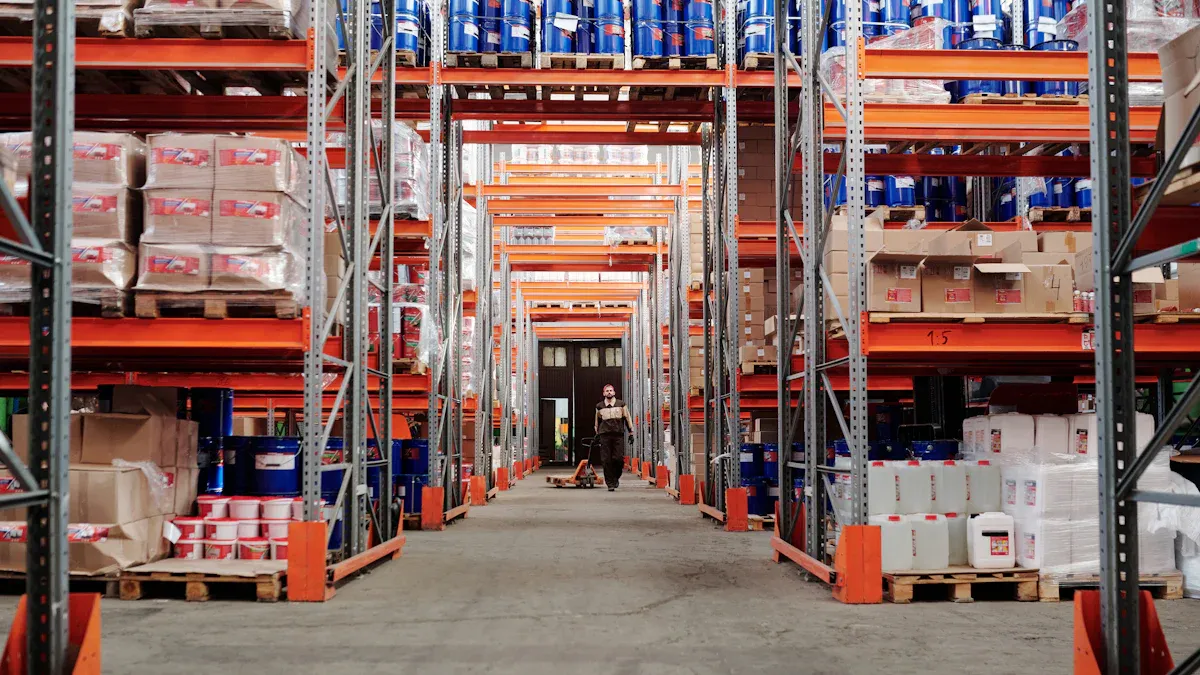Why Static Delivery Plans Fail in Same-Day Retail

Static delivery plans struggle to meet the demands of same-day retail. They cannot adjust to real-time changes, which leaves you facing delays and unhappy customers. For example, 20% of customer complaints stem from long delivery times. When demand spikes, 73% of businesses relying on in-house fleets fail to keep up. This inefficiency directly affects customer satisfaction, with 96% of people agreeing that timely delivery is vital. These rigid systems create a bottleneck, making it impossible to stay competitive in today’s fast-paced retail environment.
Key Takeaways
Fixed delivery plans can't adjust to changes quickly. This causes delays and upset customers.
Flexible delivery systems use live data to plan better routes. They also use resources more wisely.
Fast delivery is very important for happy customers. About 96% of people say it's key to a good experience.
Teaching your team new skills helps them adjust faster. This leads to better work and happier customers.
Switching to flexible systems helps businesses compete and handle more same-day orders.
Understanding Static Delivery Plans
Definition and Purpose
Static delivery plans rely on pre-determined schedules and routes to manage deliveries. These plans aim to streamline operations by creating fixed delivery patterns that minimize decision-making during execution. You might find them appealing because they simplify logistics and reduce upfront planning costs. However, their rigidity often becomes a drawback when conditions change unexpectedly.
In retail, static delivery plans are designed to handle predictable demand. For example, they work well for scheduled deliveries to stores or warehouses. But when customer orders spike or traffic disrupts routes, these plans struggle to adapt. Their inability to respond to real-time changes often leads to inefficiencies, delays, and dissatisfied customers.
Common Applications in Retail
Static delivery plans are commonly used in scenarios where demand patterns remain stable. Retailers often employ them for inventory replenishment or bulk shipments. These plans also support zone-based delivery systems, where couriers follow fixed routes within designated areas.
Research highlights how static delivery plans influence pricing strategies and performance in retail. For instance, platforms with established networks of couriers and users achieve shorter wait times, making them more efficient for predictable deliveries. Zone-based pricing schemes, which align with static plans, optimize costs by grouping deliveries within specific areas.
Study | Focus | Findings |
|---|---|---|
Kung and Zhong (2017) | Pricing strategy | Explores optimal pricing strategies for platforms using static delivery. |
Tong et al. (2020) | Pricing strategies | Compares dynamic and static pricing impacts on platform performance. |
Feldman et al. (2019) | Contractual forms | Examines delivery platform contracts and their efficiency in retail. |
These studies show that static delivery plans work best when conditions are predictable. However, their limitations become evident in fast-paced retail environments where flexibility is crucial.
Challenges of Static Delivery Plans

Lack of Flexibility
Static delivery plans lack the ability to adapt to unexpected changes. When you rely on fixed schedules and routes, disruptions like traffic jams or sudden spikes in orders can throw your entire operation off track. For example, if a major road closes unexpectedly, your delivery drivers must stick to pre-planned routes, even if faster alternatives exist. This rigidity prevents you from responding to real-time challenges, leaving customers waiting longer than expected.
Retail operations often face unpredictable conditions. Weather changes, last-minute orders, or sudden demand surges require quick adjustments. Static delivery plans, built on historical data and regular schedules, fail to accommodate these dynamic needs. This inability to pivot creates inefficiencies that ripple through your logistics chain, slowing down deliveries and frustrating customers.
Tip: To stay competitive, you need delivery systems that can adapt to real-time conditions and optimize routes on the fly.
Inefficiency in Resource Allocation
Static delivery plans often lead to poor resource allocation. Fixed routes and schedules may seem efficient on paper, but they rarely account for real-world variables. For instance, during peak hours, some delivery zones might experience higher demand while others remain underutilized. Static plans fail to redistribute resources effectively, leaving some drivers overwhelmed while others idle.
This inefficiency wastes time, fuel, and manpower. When your delivery fleet operates under rigid plans, it cannot adjust to fluctuating demand. Research confirms that relying solely on static routing results in delays and operational inefficiencies. These inefficiencies not only increase costs but also reduce your ability to meet customer expectations.
Note: Dynamic delivery systems can help you allocate resources more efficiently by analyzing real-time data and adjusting operations accordingly.
Impact on Customer Satisfaction
Customer satisfaction suffers when deliveries are delayed or mishandled. Static delivery plans, with their inability to adapt, often fail to meet the expectations of same-day retail customers. Imagine a scenario where a customer places an urgent order, but your delivery system cannot prioritize it due to pre-set schedules. This lack of responsiveness leaves customers disappointed and less likely to return.
Timely delivery is a top priority for most customers. Studies show that 96% of people consider on-time delivery essential for a positive shopping experience. Static delivery plans, however, struggle to meet this demand. Their rigidity leads to missed deadlines, which directly impacts your reputation and customer loyalty.
Alert: In today’s fast-paced retail environment, customer satisfaction hinges on your ability to deliver quickly and efficiently.
Demands of Same-Day Retail

Need for Speed and Responsiveness
In same-day retail, speed and responsiveness are no longer optional. Customers expect their orders to arrive quickly, and many are willing to pay extra for this convenience. In fact:
46% of consumers are ready to spend more for same-day delivery.
49% say the availability of same-day delivery influences their online shopping decisions.
The market for same-day delivery reflects this growing demand.
Year | Market Size (USD Billion) | CAGR (%) |
|---|---|---|
2023 | 10.1 | 20.8 |
2024 | 12.2 | N/A |
2025 | 14.7 | N/A |
This rapid growth highlights the importance of meeting customer expectations. Companies that fail to deliver quickly risk losing customers to competitors who prioritize speed.
Quote: "Timeliness has always been important. And today, responsive action—doing things in a timely fashion—is even more crucial. Companies that cater to time-conscious customers are everywhere you look."
Managing Dynamic Delivery Conditions
Dynamic conditions like traffic, weather, and fluctuating demand make same-day delivery challenging. To succeed, you need systems that adapt to these variables. Retailers can optimize operations by:
Adjusting prices based on stock levels and time of day.
Using sales data to identify inventory gaps and act quickly.
Leveraging advanced analytics to focus on exceptions, improving productivity.
These strategies help you stay agile and maintain efficiency, even when conditions change unexpectedly.
Importance of Real-Time Adaptability
Real-time adaptability is essential for modern delivery systems. Businesses like Itsu and McDonald's have used real-time tools to improve efficiency and protect profits. For example, Itsu integrates live operational data to manage peak-hour product availability, while McDonald's uses similar systems to monitor events and respond instantly.
Real-time tracking also enhances customer satisfaction. When customers can monitor their delivery status, they feel more confident and engaged. This transparency builds trust and ensures a better overall experience.
Dynamic Delivery Systems as a Solution
Features of Dynamic Systems
Dynamic delivery systems are designed to adapt to changing conditions in real time. These systems leverage advanced technologies to optimize delivery operations and improve efficiency. Key features include:
Agility in technology management: Dynamic systems adjust quickly to disruptions, ensuring service continuity.
Automated processes: Contactless delivery and enhanced human interaction are orchestrated seamlessly.
AI-driven task assignment: Artificial intelligence assigns tasks based on proximity, availability, and capacity, reducing delays.
FIFO (First-In-First-Out) programs: Orders are prioritized based on age, ensuring food quality and customer satisfaction.
Real-time route planning: Integrated data enables dynamic adjustments to delivery routes, improving speed and reducing costs.
Predictive analytics: These tools anticipate peak periods, helping you allocate resources effectively and avoid bottlenecks.
Dynamic systems empower you to stay ahead in fast-paced retail environments. By leveraging these features, you can enhance operational efficiency and meet customer expectations consistently.
Advantages Over Static Plans
Dynamic delivery systems outperform static models in several critical areas. They offer flexibility, efficiency, and improved customer satisfaction. Comparative studies highlight the following advantages:
Metric | Dynamic Delivery Systems | Static Plans | Improvement (%) |
|---|---|---|---|
Total distance traveled | N/A | 22% | |
Average cost savings | 19% | N/A | 19% |
On-time delivery rates | Improved by 18% | N/A | 18% |
Late deliveries | Reduced by 28% | N/A | 28% |
Productivity increase | 53% | N/A | 53% |
Delivery delays | Reduced by up to 25% | N/A | 25% |
Customer satisfaction score | Increased by 16% | N/A | 16% |
Efficiency of routes compared to human | 40% more efficient | N/A | 40% |
Dynamic pricing strategies also contribute to these advantages. Unlike static pricing, which relies on fixed factors like distance, dynamic pricing adjusts based on demand, weather, and promotions. This adaptability significantly boosts demand and ensures better resource allocation.
Dynamic systems reduce inefficiencies and improve delivery outcomes. They help you save costs, increase productivity, and enhance customer satisfaction, making them a superior choice for same-day retail.
Examples of Successful Implementation
Several companies have successfully implemented dynamic delivery systems to transform their operations. These examples demonstrate the practical benefits of adopting dynamic models:
Company | Implementation Details | Outcomes |
|---|---|---|
Company A | Implemented an electronic POD system for capturing delivery information digitally. | Streamlined operations, reduced paperwork, improved efficiency. |
Company B | Provided real-time tracking updates to customers through a POD system. | Increased customer satisfaction, reduced inquiries about delivery status. |
Company C | Required digital signatures upon delivery to mitigate disputes. | Reduced delivery-related complaints, improved trust and accountability. |
Company D | Integrated POD system with existing fleet management software. | Achieved cost savings, improved customer satisfaction. |
These companies leveraged dynamic systems to address common challenges in delivery operations. For instance, real-time tracking updates allowed Company B to enhance transparency and build trust with customers. Digital signatures helped Company C reduce disputes and improve accountability. By integrating dynamic systems, these businesses achieved measurable improvements in efficiency, customer satisfaction, and cost savings.
Dynamic delivery systems are not just theoretical solutions. They are proven tools that help you overcome logistical challenges and deliver exceptional results in same-day retail.
Steps to Transition from Static to Dynamic Delivery
Evaluating Current Delivery Models
Before transitioning to a dynamic delivery system, you need to assess your current static model. This evaluation helps you identify inefficiencies and areas for improvement. Start by analyzing how well your existing system meets customer expectations and operational goals.
A comparison of static and dynamic models can provide valuable insights:
Model Type | Advantages | Limitations |
|---|---|---|
Static | Simplifies planning; offers predictable outcomes. | Struggles with variability; lacks flexibility for real-time adjustments. |
Dynamic | Adapts to changing conditions; improves accuracy and efficiency. | Requires more resources and advanced technology for implementation. |
Understanding these differences allows you to pinpoint where your static model falls short. For example, static systems often fail to account for fluctuating demand or traffic conditions. By identifying these gaps, you can create a roadmap for adopting a dynamic approach.
Tip: Involve all stakeholders during this evaluation to ensure a comprehensive understanding of the transition's impact on your operations and customers.
Leveraging Real-Time Technology
Real-time technology is the backbone of dynamic delivery systems. It enables you to respond quickly to changing conditions, such as traffic or weather. By integrating data-driven tools, you can optimize routes, allocate resources efficiently, and enhance overall performance.
Key benefits of real-time technology include:
Improved agility in managing delivery operations.
Enhanced collaboration through performance management tools.
Just-in-time data for better decision-making.
For example, performance management tools act as digital partners, helping teams adapt to disruptions while maintaining efficiency. These tools also provide analytics that predict peak periods, allowing you to prepare in advance.
Callout: Companies that leverage real-time technology report significant improvements in delivery speed and customer satisfaction.
Training Teams for Adaptability
Your team plays a crucial role in the success of a dynamic delivery system. Training programs focused on adaptability ensure your workforce can handle new tools and processes effectively. Structured training not only boosts employee confidence but also enhances overall performance.
Statistics show the impact of adaptability training:
Statistic Description | Value |
|---|---|
Employee Engagement Increase | 1.5x |
Performance in Innovation Initiatives | 2.5x |
Resilience Increase | 25% |
Time to Adapt to New Tools/Processes Decrease | 30% |
Customer Satisfaction Improvement | 14% |
Profit Margin Increase | 24% |
Effectiveness in Responding to Market Changes | 57% |
Improvement in Employee Engagement and Performance | 20% |
By investing in training, you prepare your team to embrace change and excel in a dynamic environment. Adaptable employees respond better to market shifts, leading to higher customer satisfaction and profitability.
Note: Regularly update training programs to align with evolving technologies and market demands.
Static delivery plans fail to meet the demands of same-day retail. Their inability to adapt to real-time changes leads to inefficiencies and delays. Dynamic delivery systems offer a better solution by optimizing operations with real-time data. For example, improving On-Time Delivery (OTD) enhances customer satisfaction and brand loyalty. Preemptive depot returns further boost efficiency by integrating new requests into existing routes. Transitioning to dynamic systems allows you to stay competitive, improve operational performance, and deliver a superior customer experience.
FAQ
What is the main drawback of static delivery plans?
Static delivery plans cannot adapt to real-time changes. This rigidity leads to inefficiencies, delays, and poor customer experiences, especially in fast-paced retail environments.
How do dynamic delivery systems improve efficiency?
Dynamic systems use real-time data to optimize routes, allocate resources, and respond to disruptions. This adaptability reduces delays, saves costs, and enhances customer satisfaction.
Are dynamic delivery systems expensive to implement?
Dynamic systems require upfront investment in technology and training. However, they save costs in the long run by improving operational efficiency and reducing delivery errors.
Can small businesses benefit from dynamic delivery systems?
Yes, small businesses can use scalable dynamic solutions to improve delivery speed and customer satisfaction. Many tools offer affordable options tailored to smaller operations.
How does real-time tracking enhance customer satisfaction?
Real-time tracking lets customers monitor their deliveries. This transparency builds trust, reduces inquiries, and ensures a better overall experience.
See Also
Effective Strategies for Retail Demand Forecasting Each Week
Understanding Short-Term Demand Forecasting Techniques and Challenges
Fundamentals of Route Optimization for Speedy Deliveries
Impact of Weather Changes on Demand Across Various Categories
